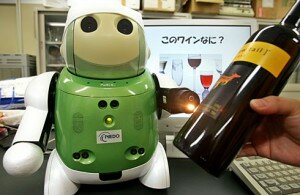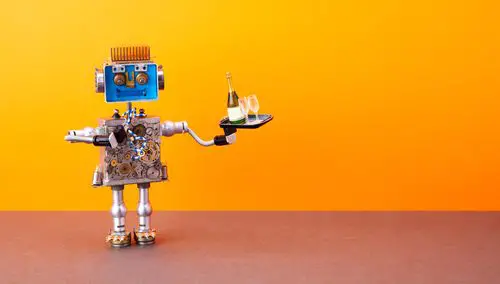Well we have had Wate r Sommeliers, Beer Sommeliers, Tea Sommeliers and even Italian Sommelier Poilce but now we have a Robot Sommelier. The Robot Sommelier comes in the form of an electronic tongue which was created by researchers at the Universitat Autònoma de Barcelona, Spain.
r Sommeliers, Beer Sommeliers, Tea Sommeliers and even Italian Sommelier Poilce but now we have a Robot Sommelier. The Robot Sommelier comes in the form of an electronic tongue which was created by researchers at the Universitat Autònoma de Barcelona, Spain.
The research team used voltammetric measurements to copy the human taste system and distinguish between different types of Cava. The electronic tongue can currently identify 3 types of Cava – Brut, Brut Nature and Medium-Dry.
Cava is an ideal wine with which to test the electronic tongue palette because types are categorized according to the amount of sugar added: ‘brut nature’ only has residual sugar while ‘sweet’ has at least 50 gL of sugar.
‘Extra brut,’ ‘brut,’ and ‘extra dry’ have intermediate and increasing amounts of sugar. That a single ingredient can be used to distinguish betw een the different types makes the task feasible.
een the different types makes the task feasible.
Lead scientist Manel del Valle told the Daily Mail that:
“You need to show it samples – teach it like you would a child and, once trained, it tells you what a new sample looks like or resembles”
He added that:
“It could perform automatic tests in the production process to detect defects and may be a replacement for the human sensory panel used by many wine producers.”
It is hoped that it will soon be able to identify all types available on the market.
Back in 2007 I wrote about The Winebot – a 2 foot tall Japanese gismo that identifies dozens of different wines and can also name the brand of cheese. It happily identified the hand of a curious reporter as “bacon”. The NECand Mie University teamed up in Japan to create The Winebot.
2007 I wrote about The Winebot – a 2 foot tall Japanese gismo that identifies dozens of different wines and can also name the brand of cheese. It happily identified the hand of a curious reporter as “bacon”. The NECand Mie University teamed up in Japan to create The Winebot.
Admittedly there are some benefits to Winebot’s capabilities, because of its ability to analyze the chemical composition of wine or food placed next to it, it could caution its owner about such health-related factors as fat or salt content.
It can also help combat wine fraud by detecting what the bottle really contains rather than what is displayed on the label.
One drawback is that it can not take part in a real wine tasting as it can not check the wine once its been opened as the air changes the wine’s chemical structure.
The Winebot doesn’t come cheap. It’s designers reckon it would cost as much as a new car but they would like to reduce that to 100,000 yen ($1,000) or less if they were to put it on the market . . . which they haven’t, as yet.

